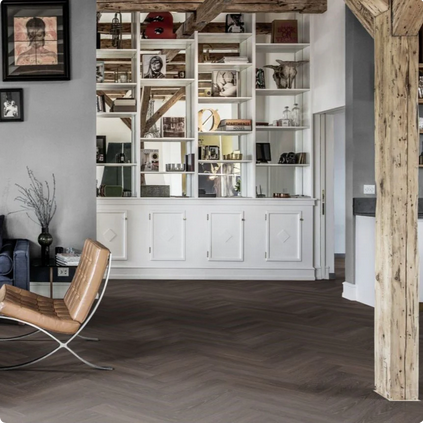
Author, Written by: Bledy (Installation Expert and Technical Writer)
Vinyl/LVT flooring is a practical, affordable, and long lasting choice, which is why it is commonly found in many older UK homes. Over time, however, even the most durable vinyl floors can begin to show signs of wear. Scuffs, dull patches, lifting edges, and stains can all make your floors look tired. Fortunately, you can often restore them without replacing the entire floor.
Whether you are a homeowner maintaining a period property or a landlord updating a rental, here’s how to bring your vinyl floors back to life.
1. Start with a Deep Clean
Before assessing the damage, give your vinyl floor a thorough clean. This will help you determine what’s permanent wear and what’s just built up dirt.
-
Sweep or hoover to remove dust and debris.
-
Use a pH-neutral cleaner or a solution of warm water and mild dish soap.
-
Avoid abrasive scrubbing pads or harsh chemicals, as these can cause further damage.
Rinse the floor well and allow it to dry completely before moving on to the next step.
2. Remove Scuff Marks and Stains
Scuff marks are common in high traffic areas, especially hallways and kitchens.
-
For minor scuffs, use a soft white rubber eraser or a solution of baking soda and water on a soft cloth.
-
Stubborn stains, like shoe polish or ink, may respond to diluted white vinegar or a touch of rubbing alcohol. Always test in an inconspicuous area first.
Never use bleach or ammonia based cleaners, as they can discolour the vinyl/LVT.
3. Restore Shine with a Vinyl Floor Polish
If your vinyl/LVT floor looks dull even after cleaning, it may benefit from a polish or finish.
-
Use a vinyl floor polish or restorer, following the manufacturer's instructions.
-
Apply it evenly across the surface using a mop or microfiber pad.
-
Let it dry completely before walking on it.
This can give older vinyl a renewed, glossy finish and help protect it from future wear.
4. Fix Peeling Edges or Lifting Seams
In older homes, vinyl/LVT tiles or sheet edges may start to lift, especially in areas prone to moisture like bathrooms or kitchens.
-
Use vinyl/LVT adhesive to reattach loose edges or seams. Clean the area first and use a roller to press the section flat until the adhesive sets.
-
If water has seeped under the flooring, the subfloor may need drying or minor repair before resealing.
For more widespread issues, consider having a flooring professional inspect for underlying moisture problems.
5. Address Small Tears and Gouges
Minor cuts or tears can often be repaired using vinyl floor repair kits.
-
These kits usually include a filler paste that can be coloured to match your flooring.
-
For more visible damage, you might need to replace individual vinyl tiles if the floor is tile based.
If you have leftover material from the original installation, this can be helpful. If not, try to match the design from the same brand or collection.
6. Add Rugs or Mats for Protection
Once your floor is looking refreshed, protect it with well placed mats and rugs.
-
Use non-slip mats at entrances to reduce dirt and moisture.
-
Place felt pads under furniture legs to avoid new scuffs or indentations.
-
In older homes, consider using area rugs in lounge or dining spaces to add warmth and character while shielding the vinyl.
7. When to Replace Instead of Repair
Sometimes vinyl/LVT is too far gone for a full revival. If the flooring is cracking, curling, or severely discoloured across large sections, it might be more cost effective to replace it.
Fortunately, many modern vinyl options mimic wood or stone and offer waterproof, easy to install designs that are ideal for busy UK households.
Wrapping Up
Reviving vinyl/LVT floors in older UK homes is often simpler than you might expect. With some cleaning, minor repairs, and a little polish, you can extend the life of your flooring and delay replacement costs. It is a practical solution for anyone looking to maintain charm and comfort in a lived-in property, whether it's a Victorian terrace or a post war flat.
About Author:
Bledy is a flooring installation expert with over 15 years of experience. He writes easy to follow guides and tips to help homeowners and professionals with flooring projects.
